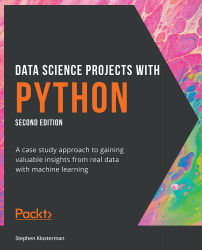Summary
In this chapter, you learned several analysis techniques to provide insight into model performance, such as decile and equal-interval charts of default rate by model prediction bin, as well as how to investigate the quality of model calibration. It's good to derive these insights, as well as calculate metrics such as the ROC AUC, using the model test set, since this is intended to represent how the model might perform in the real world on new data.
We also saw how to go about conducting a financial analysis of model performance. While we left this to the end of the book, an understanding of the costs and savings going along with the decisions to be guided by the model should be understood from the beginning of a typical project. These allow the data scientist to work toward a tangible goal in terms of increased profit or savings. A key step in this process, for binary classification models, is to choose a threshold of predicted probability at which to declare a positive...



